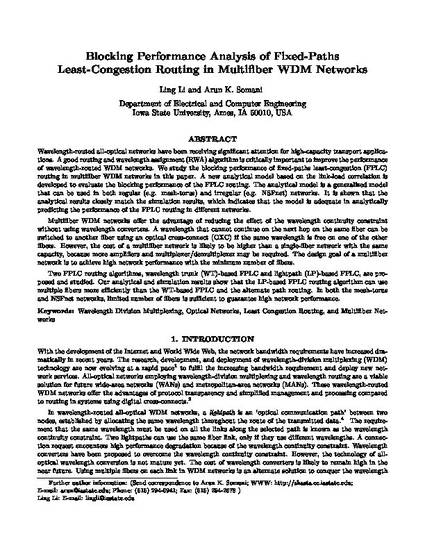
Wavelength‐routed all‐optical networks have been receiving significant attention for high‐capacity transport applications. Good routing and wavelength assignment (RWA) algorithms are critically important in order to improve the performance of wavelength‐routed WDM networks. Multifibre WDM networks, in which each link consists of multiple fibres and each fibre carries information on multiple wavelengths, offer the advantage of reducing the effect of the wavelength continuity constraint without using wavelength converters. A wavelength that cannot continue on the next hop on the same fibre can be switched to another fibre using an optical cross‐connect (OXC) if the same wavelength is free on one of the other fibres. However, the cost of a multifibre network is likely to be higher than a single‐fibre network with the same capacity, because more amplifiers and multiplexers/demultiplexers may be required. The design goal of a multifibre network is to achieve a high network performance with the minimum number of fibres.
In this paper, we study the blocking performance of fixed‐paths least‐congestion (FPLC) routing in multifibre WDM networks. A new analytical model with the consideration of link‐load correlation is developed to evaluate the blocking performance of the FPLC routing. The analytical model is a generalized model that can be used in both regular (e.g. mesh‐torus) and irregular (e.g. NSFnet) networks. It is shown that the analytical results closely match the simulation results, which indicate that the model is adequate in analytically predicting the performance of the FPLC routing in different networks.
Two FPLC routing algorithms, wavelength trunk (WT)‐based FPLC and lightpath (LP)‐based FPLC, are developed and studied. Our analytical and simulation results show that the LP‐based FPLC routing algorithm can use multiple fibres more efficiently than the WT‐based FPLC and the alternate path routing. In both the mesh‐torus and NSFnet networks, limited number of fibres is sufficient to guarantee high network performance.
Available at: http://works.bepress.com/arun-somani/37/

This is the peer-reviewed version of the following article: Li, Ling, and Arun K. Somani. "Blocking performance of fixed‐paths least‐congestion routing in multifibre WDM networks." International Journal of Communication Systems 15, no. 2‐3 (2002): 143-159, which has been published in final form at DOI: 10.1002/dac.524. This article may be used for non-commercial purposes in accordance with Wiley Terms and Conditions for Self-Archiving. Posted with permission.